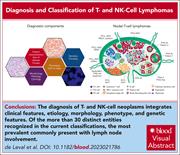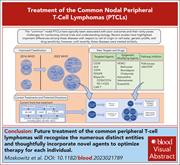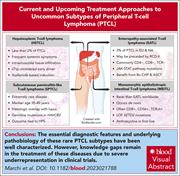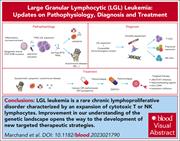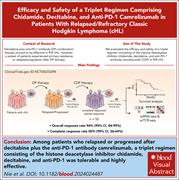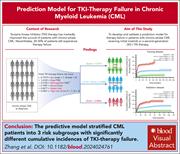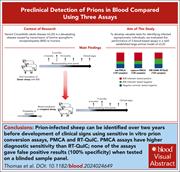Issue Archive
Table of Contents
EDITORIAL
Introduction to a review series on peripheral T-cell lymphomas: salutary complexity?
Peripheral T-cell lymphomas are rare and have poorer prognoses than more common B-cell lymphomas. It is therefore appropriate to highlight the current state of knowledge about this heterogeneous cluster of lymphoproliferative diseases. Associate Editor Philippe Armand introduces this series of 5 reviews covering the biology, diagnosis, and treatment of this multitude of distinct entities, including T-cell large granular lymphocytic leukemia.
BLOOD COMMENTARIES
REVIEW SERIES
A practical approach to the modern diagnosis and classification of T- and NK-cell lymphomas
Peripheral T-cell lymphomas are rare and have poorer prognoses than more common B-cell lymphomas. It is therefore appropriate to highlight the current state of knowledge about this heterogeneous cluster of lymphoproliferative diseases. Associate Editor Philippe Armand introduces this series of 5 reviews covering the biology, diagnosis, and treatment of this multitude of distinct entities, including T-cell large granular lymphocytic leukemia.
New insights into the biology of T-cell lymphomas
Peripheral T-cell lymphomas are rare and have poorer prognoses than more common B-cell lymphomas. It is therefore appropriate to highlight the current state of knowledge about this heterogeneous cluster of lymphoproliferative diseases. Associate Editor Philippe Armand introduces this series of 5 reviews covering the biology, diagnosis, and treatment of this multitude of distinct entities, including T-cell large granular lymphocytic leukemia.
Current and upcoming treatment approaches to common subtypes of PTCL (PTCL, NOS; ALCL; and TFHs)
Peripheral T-cell lymphomas are rare and have poorer prognoses than more common B-cell lymphomas. It is therefore appropriate to highlight the current state of knowledge about this heterogeneous cluster of lymphoproliferative diseases. Associate Editor Philippe Armand introduces this series of 5 reviews covering the biology, diagnosis, and treatment of this multitude of distinct entities, including T-cell large granular lymphocytic leukemia.
Current and upcoming treatment approaches to uncommon subtypes of PTCL (EATL, MEITL, SPTCL, and HSTCL)
Peripheral T-cell lymphomas are rare and have poorer prognoses than more common B-cell lymphomas. It is therefore appropriate to highlight the current state of knowledge about this heterogeneous cluster of lymphoproliferative diseases. Associate Editor Philippe Armand introduces this series of 5 reviews covering the biology, diagnosis, and treatment of this multitude of distinct entities, including T-cell large granular lymphocytic leukemia.
A modern view of LGL leukemia
Peripheral T-cell lymphomas are rare and have poorer prognoses than more common B-cell lymphomas. It is therefore appropriate to highlight the current state of knowledge about this heterogeneous cluster of lymphoproliferative diseases. Associate Editor Philippe Armand introduces this series of 5 reviews covering the biology, diagnosis, and treatment of this multitude of distinct entities, including T-cell large granular lymphocytic leukemia.
CLINICAL TRIALS AND OBSERVATIONS
Venetoclax-obinutuzumab for previously untreated chronic lymphocytic leukemia: 6-year results of the randomized phase 3 CLL14 study
Clinical Trials & Observations
Al-Sawaf and colleagues report the 6-year results of the CLL14 study, a multicenter open label phase 3 trial for older treatment-naive patients with chronic lymphocytic leukemia and coexisting conditions, comparing 1-year fixed-duration venetoclax-obinutuzumab (VO) with chlorambucil-obinutuzumab. Five years after all patients completed therapy, 67% of patients who received VO have not required more therapy and 53% have not progressed, rates double that seen with the previous standard therapy, with the greatest incremental improvements seen in those with poor prognosis genetics. Patients who received VO have better quality of life, better global health status, and improved survival, with no significant excess of second cancers.
IMMUNOBIOLOGY AND IMMUNOTHERAPY
Epigenetic agents plus anti-PD-1 reprogram the tumor microenvironment and restore antitumor efficacy in Hodgkin lymphoma
Clinical Trials & Observations
For patients with relapsed classical Hodgkin lymphoma (HL), checkpoint inhibitor therapy has high response rates, but most patients relapse within 5 years. Trialing an epigenetic-immunotherapy regimen consisting of the histone deacetylase inhibitor chidamide, decitabine, and the anti–PD-1 antibody camrelizumab, Nie et al report a 50% complete response rate and restored antitumor immunity in heavily treated patients, including those previously receiving anti–PD-1-based therapy. Through comprehensive single-cell analyses of longitudinal HL biopsies, they identify correlates of response and resistance, providing insights into both the biology of the disease and the activity of the regimen.
MYELOID NEOPLASIA
A predictive model for therapy failure in patients with chronic myeloid leukemia receiving tyrosine kinase inhibitor therapy
Clinical Trials & Observations
The use of ABL tyrosine kinase inhibitors (TKIs) means that survival of most patients with chronic myeloid leukemia (CML) approaches that of people without the disease, and consequently prospective identification of patients destined to fail TKI therapy is a research priority. Zhang and colleagues propose a scoring system to predict the risk of first-line TKI failure, which they validated in an independent cohort of more than 3400 patients with chronic-phase CML. Their system outperforms existing scores and identifies a high-risk group with a failure rate of >70% at 8 years for future attention.
TRANSFUSION MEDICINE
Longitudinal detection of prion infection in preclinical sheep blood samples compared using 3 assays
As yet, there is no practical and robust blood diagnostic test for variant Creutzfeldt-Jakob disease (vCJD), a prion disease that can be transmitted by blood transfusion. Thomas et al report a comparative analysis of 3 highly specific blood assays to detect disease-associated prion protein in blood of sheep infected with bovine spongiform encephalopathy as a model of human vCJD. Their research will accelerate the development of a much-needed human vCJD blood assay.
BLOOD WORK
-
Cover Image
Cover Image
![issue cover]()
Neoplastic lymphocytes show striking infiltration of the surface epithelium in a case of monomorphic epitheliotropic intestinal T-cell lymphoma with extensive small bowel involvement. See the article by Marchi et al on page 1898.
- PDF Icon Front MatterFront Matter
- PDF Icon Table of ContentsTable of Contents
- PDF Icon Editorial BoardEditorial Board
Advertisement intended for health care professionals
Email alerts
Advertisement intended for health care professionals


